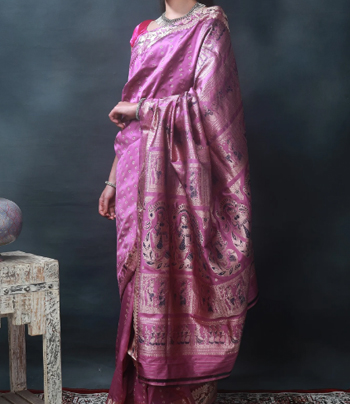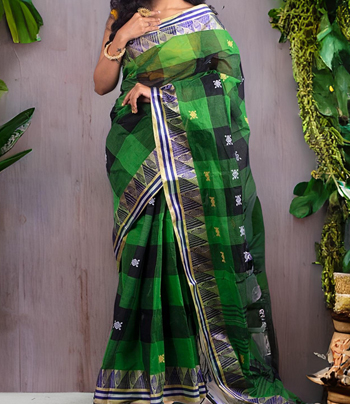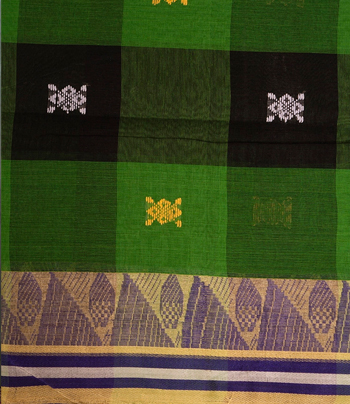Santipore Saree
Santipur Saree in its present form may be defined as the Saree which is traditionally woven in Fly Shuttle Frame/Pit Looms using 80s-100s cotton yarn in warp and weft with plain border and/or border with extra warp jacquard designs of different characteristics viz. floral, abstract, geometrical, instrumental motifs, special motifs of different historical backgrounds, temples and other natural motifs with typical color patterns in pallu. Body of the fabric may be plain or decorated with “Buti” using Extra Warp/ Weft with or without the help of jacquard. Ten different types of products were woven depending on the complexity of the patterns woven and the number of colors of threads used. These were – sada, rangeen, dure (ten different coloured threads were used), sarbasundari, kharkemoti, sinduri, chaurangi, tashkhupi, choukhupi, ayanakhupi etc. The edges or paras of the saris also had variety – chandmama, taj, tajkalka, choukalka, phuljhumka, parijaat, dhakai, karnish, tekka etc.
Santipur Saree in its present form may be defined as the Saree which is traditionally woven in Fly Shuttle Frame/Pit Looms using 80s-100s cotton yarn in warp and weft with plain border and/or border with extra warp jacquard designs of different characteristics viz. floral, abstract, geometrical, instrumental motifs, special motifs of different historical backgrounds, temples and other natural motifs with typical color patterns in pallu. Body of the fabric may be plain or decorated with “Buti” using Extra Warp/ Weft with or without the help of jacquard. Speciality of Santipur Saree is that it is marketed in a typical traditional folded form known as “Guti Bhanj ''.
Baluchari Sari
Baluchari Sari is a type of sari, a garment worn by women in Bangladesh and Indian States of West Bengal. This particular type of sari originated in West Bengal and is known for depictions of mythological scenes on the pallu of the sari. It used to be produced in Murshidabad but presently Bishnupur and its surrounding areas of West Bengal are the only place where authentic Baluchari sarees are produced. It takes approximately one week to produce one such sari.In 2011, the Baluchari Sari was granted the status of Geographical Indication for West Bengal in India.
In the history of textiles in Bengal, Baluchari came much after muslin. Two hundred years ago Baluchari was practiced in a small village called Baluchar in Murshidabad district, from where it got its name. In the eighteenth century, Murshidkuli Khan, Nawab of Bengal patronized its rich weaving tradition and brought the craft of making this sari from Dhaka to the Baluchar village in Murshidabad and encouraged the industry to flourish. After a flood of the Ganga river and the subsequent submerging of the village, the industry moved to Bishnupur village in Bankura district. Baluchari Sari is made of tussar silk and was a thousand years old when the Jagat Malla king ruled in Mallabhum. This flourishing trend later declined, especially during British rule, due to political and financial reasons. It became a dying craft as most of the weavers were compelled to give up the profession.
Dhaniakhali Saree
Dhaniakhali Saree is named after the place Dhaniakhali in Hooghly District, West Bengal. It is located about 50 kms away from Kolkata. In earlier days the ground of the saree used to be in ‘Kora’ or natural gray with either red or black color plain border. By taking the concept of decorative border design of dhoti the use of 6 levers’ kat-kal’ or barrel dobby came into practice for saree weaving during early 1940 . Dyed yarn was first introduced in 1942. Nowadays, lattice dobby is used for weaving bigger designs. Dhaniakhali sarees are produced in Haripal, Rajbalhat Rasidpur, Dwarhata, Ramnagar, Gurap and Antpur area of Hooghly District in West Bengal.
Dhaniakhali Saree can easily be distinguished by the presence of ‘khejur chori’ design thread, an arrangement of special weft threads of twisted cotton yarns in two colors woven in pallu portion. In this saree picks per inch is always more than ends per inch. Grouping of two warp threads in the saree is noticed since bamboo reed is used.
Source: Wikipedia

.jpg)
-2.jpg)





